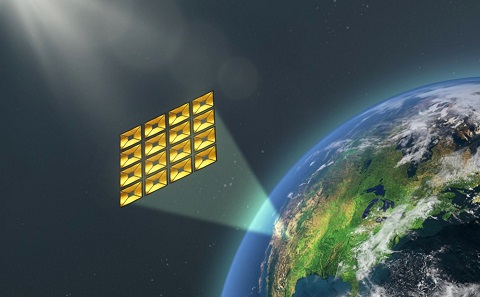Southampton's contribution in advancing space-based solar power receives government funding

As part of the Space Based Solar Power Innovation Competition, Southampton, in collaboration with the University of Cambridge and IQE plc., has won over £770,000 in government funding to develop ultra-lightweight solar panels capable of withstanding the harsh conditions of space.
The concept of space-based solar power (SBSP) involves collecting solar energy using panels in space and transmitting it back to Earth, avoiding the atmospheric and weather losses and the day-night cycle that terrestrial solar faces. With the potential to generate up to 10GW of electricity annually by 2050, accounting for a quarter of the UK's current electricity demand, this innovative technology could play a crucial role in achieving the country's net-zero goals.
One of the key challenges faced in implementing space-based solar power is the high ionizing-radiation levels in space that can damage the system. To overcome this hurdle, Southampton researchers, including Professor Otto Muskens from the School of Physics and Astronomy and Dr Nina Vaidya, assistant professor, from the School of Engineering and Physical Sciences, have been working on developing a novel concentrator photovoltaic device capable of surviving extended missions in space while efficiently converting solar energy into electricity.
Dr Nina Vaidya, who was part of the Caltech team that successfully launched a space-based solar power demo earlier this year, invented a new type of ultralightweight space reflector and created SBSP prototypes. These highly efficient space reflectors can focus sunlight 15-fold despite having thicknesses of less than 100 microns; resulting in an areal mass of up to a few milligrams per cm2 which is crucial to keep launch mass and costs feasible. These reflectors also maintain their nominal shape even after folding and unfolding and withstand space radiation, ensuring their deployment after launch and resilience in harsh space environments. Vaidya brings with her the past experience in SBSP and an enthusiasm to go forwards.
"Physics and materials innovations, new fabrication techniques, and economies of scale have already made solar energy competitive with other conventional sources, which can be applicable to space-based solar power in the future. This dispatchable energy harvested in space has the potential to provide a global supply of clean and affordable energy, particularly in areas currently lacking access to electricity, while contributing to our sustainability and circular economy aims." (Dr Nina Vaidya, Engineering, FEPS).
In conjunction with the ultrathin device, the team plans to employ an integrated light management system that concentrates sunlight onto the device, thereby maximising its efficiency. Additionally, a special thin film coating will be utilised to release excess heat into the colder surrounding environment, ensuring the longevity of the satellites and enhancing energy yields while reducing costs per unit of energy.
The Southampton project is just one of eight initiatives awarded government funding through the Space Based Solar Power Innovation Competition, a part of the flagship £1 billion Net Zero Innovation Portfolio. Other recipients include Queen Mary University in London, MicroLink Devices UK Ltd in Port Talbot, the University of Bristol, Satellite Applications Catapult Ltd in Didcot, Imperial College London, and EDF Energy R&D UK Centre Ltd. Each project is set to contribute to the advancement of space-based solar power and its integration into the UK's electricity grid, furthering the nation's commitment to a sustainable and green future.
"The project brings together expertise in state of the art solar cell design from our partners Cambridge and IQE with original thin-film radiative cooling concepts developed in Southampton using our advanced cleanroom fabrication facilities. We are very excited to contribute towards making large scale solar energy harvesting in space a reality." (Professor Otto Muskens, Physics and Astronomy, FEPS).